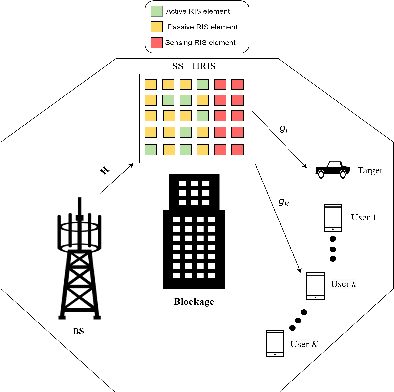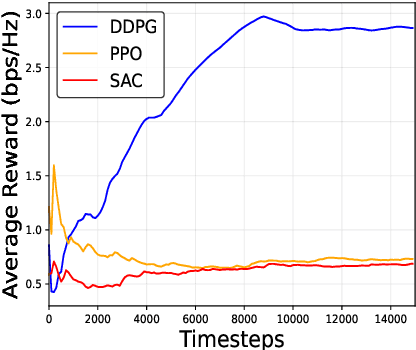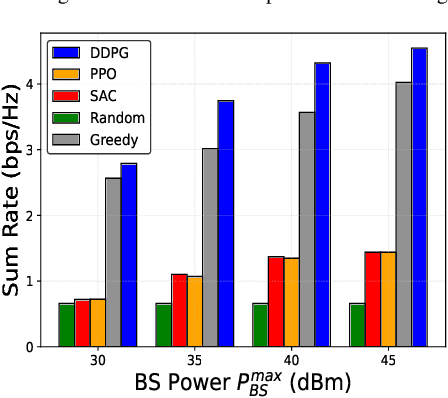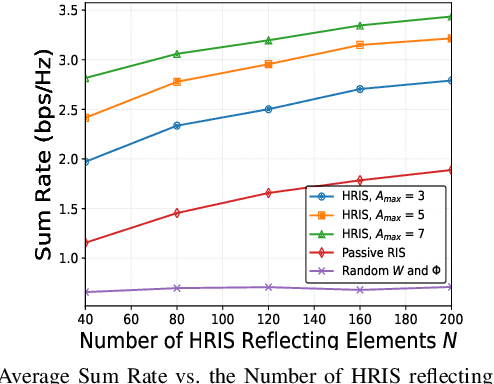Melike Erol-Kantarci
Foundation Model-Aided Deep Reinforcement Learning for RIS-Assisted Wireless Communication
Jun 11, 2025Abstract:Reconfigurable intelligent surfaces (RIS) have emerged as a promising technology for enhancing wireless communication by dynamically controlling signal propagation in the environment. However, their efficient deployment relies on accurate channel state information (CSI), which leads to high channel estimation overhead due to their passive nature and the large number of reflective elements. In this work, we solve this challenge by proposing a novel framework that leverages a pre-trained open-source foundation model (FM) named large wireless model (LWM) to process wireless channels and generate versatile and contextualized channel embeddings. These embeddings are then used for the joint optimization of the BS beamforming and RIS configurations. To be more specific, for joint optimization, we design a deep reinforcement learning (DRL) model to automatically select the BS beamforming vector and RIS phase-shift matrix, aiming to maximize the spectral efficiency (SE). This work shows that a pre-trained FM for radio signal understanding can be fine-tuned and integrated with DRL for effective decision-making in wireless networks. It highlights the potential of modality-specific FMs in real-world network optimization. According to the simulation results, the proposed method outperforms the DRL-based approach and beam sweeping-based approach, achieving 9.89% and 43.66% higher SE, respectively.
Conditional Denoising Diffusion for ISAC Enhanced Channel Estimation in Cell-Free 6G
Jun 07, 2025Abstract:Cell-free Integrated Sensing and Communication (ISAC) aims to revolutionize 6th Generation (6G) networks. By combining distributed access points with ISAC capabilities, it boosts spectral efficiency, situational awareness, and communication reliability. Channel estimation is a critical step in cell-free ISAC systems to ensure reliable communication, but its performance is usually limited by challenges such as pilot contamination and noisy channel estimates. This paper presents a novel framework leveraging sensing information as a key input within a Conditional Denoising Diffusion Model (CDDM). In this framework, we integrate CDDM with a Multimodal Transformer (MMT) to enhance channel estimation in ISAC-enabled cell-free systems. The MMT encoder effectively captures inter-modal relationships between sensing and location data, enabling the CDDM to iteratively denoise and refine channel estimates. Simulation results demonstrate that the proposed approach achieves significant performance gains. As compared with Least Squares (LS) and Minimum Mean Squared Error (MMSE) estimators, the proposed model achieves normalized mean squared error (NMSE) improvements of 8 dB and 9 dB, respectively. Moreover, we achieve a 27.8% NMSE improvement compared to the traditional denoising diffusion model (TDDM), which does not incorporate sensing channel information. Additionally, the model exhibits higher robustness against pilot contamination and maintains high accuracy under challenging conditions, such as low signal-to-noise ratios (SNRs). According to the simulation results, the model performs well for users near sensing targets by leveraging the correlation between sensing and communication channels.
Intelligent Attacks and Defense Methods in Federated Learning-enabled Energy-Efficient Wireless Networks
Apr 25, 2025Abstract:Federated learning (FL) is a promising technique for learning-based functions in wireless networks, thanks to its distributed implementation capability. On the other hand, distributed learning may increase the risk of exposure to malicious attacks where attacks on a local model may spread to other models by parameter exchange. Meanwhile, such attacks can be hard to detect due to the dynamic wireless environment, especially considering local models can be heterogeneous with non-independent and identically distributed (non-IID) data. Therefore, it is critical to evaluate the effect of malicious attacks and develop advanced defense techniques for FL-enabled wireless networks. In this work, we introduce a federated deep reinforcement learning-based cell sleep control scenario that enhances the energy efficiency of the network. We propose multiple intelligent attacks targeting the learning-based approach and we propose defense methods to mitigate such attacks. In particular, we have designed two attack models, generative adversarial network (GAN)-enhanced model poisoning attack and regularization-based model poisoning attack. As a counteraction, we have proposed two defense schemes, autoencoder-based defense, and knowledge distillation (KD)-enabled defense. The autoencoder-based defense method leverages an autoencoder to identify the malicious participants and only aggregate the parameters of benign local models during the global aggregation, while KD-based defense protects the model from attacks by controlling the knowledge transferred between the global model and local models.
Beam Selection in ISAC using Contextual Bandit with Multi-modal Transformer and Transfer Learning
Mar 11, 2025



Abstract:Sixth generation (6G) wireless technology is anticipated to introduce Integrated Sensing and Communication (ISAC) as a transformative paradigm. ISAC unifies wireless communication and RADAR or other forms of sensing to optimize spectral and hardware resources. This paper presents a pioneering framework that leverages ISAC sensing data to enhance beam selection processes in complex indoor environments. By integrating multi-modal transformer models with a multi-agent contextual bandit algorithm, our approach utilizes ISAC sensing data to improve communication performance and achieves high spectral efficiency (SE). Specifically, the multi-modal transformer can capture inter-modal relationships, enhancing model generalization across diverse scenarios. Experimental evaluations on the DeepSense 6G dataset demonstrate that our model outperforms traditional deep reinforcement learning (DRL) methods, achieving superior beam prediction accuracy and adaptability. In the single-user scenario, we achieve an average SE regret improvement of 49.6% as compared to DRL. Furthermore, we employ transfer reinforcement learning to reduce training time and improve model performance in multi-user environments. In the multi-user scenario, this approach enhances the average SE regret, which is a measure to demonstrate how far the learned policy is from the optimal SE policy, by 19.7% compared to training from scratch, even when the latter is trained 100 times longer.
Heuristic Deep Reinforcement Learning for Phase Shift Optimization in RIS-assisted Secure Satellite Communication Systems with RSMA
Jan 21, 2025Abstract:This paper presents a novel heuristic deep reinforcement learning (HDRL) framework designed to optimize reconfigurable intelligent surface (RIS) phase shifts in secure satellite communication systems utilizing rate splitting multiple access (RSMA). The proposed HDRL approach addresses the challenges of large action spaces inherent in deep reinforcement learning by integrating heuristic algorithms, thus improving exploration efficiency and leading to faster convergence toward optimal solutions. We validate the effectiveness of HDRL through comprehensive simulations, demonstrating its superiority over traditional algorithms, including random phase shift, greedy algorithm, exhaustive search, and Deep Q-Network (DQN), in terms of secure sum rate and computational efficiency. Additionally, we compare the performance of RSMA with non-orthogonal multiple access (NOMA), highlighting that RSMA, particularly when implemented with an increased number of RIS elements, significantly enhances secure communication performance. The results indicate that HDRL is a powerful tool for improving the security and reliability of RSMA satellite communication systems, offering a practical balance between performance and computational demands.
Sum Rate Enhancement using Machine Learning for Semi-Self Sensing Hybrid RIS-Enabled ISAC in THz Bands
Jan 21, 2025



Abstract:This paper proposes a novel semi-self sensing hybrid reconfigurable intelligent surface (SS-HRIS) in terahertz (THz) bands, where the RIS is equipped with reflecting elements divided between passive and active elements in addition to sensing elements. SS-HRIS along with integrated sensing and communications (ISAC) can help to mitigate the multipath attenuation that is abundant in THz bands. In our proposed scheme, sensors are configured at the SS-HRIS to receive the radar echo signal from a target. A joint base station (BS) beamforming and HRIS precoding matrix optimization problem is proposed to maximize the sum rate of communication users while maintaining satisfactory sensing performance measured by the Cramer-Rao bound (CRB) for estimating the direction of angles of arrival (AoA) of the echo signal and thermal noise at the target. The CRB expression is first derived and the sum rate maximization problem is formulated subject to communication and sensing performance constraints. To solve the complex non-convex optimization problem, deep deterministic policy gradient (DDPG)-based deep reinforcement learning (DRL) algorithm is proposed, where the reward function, the action space and the state space are modeled. Simulation results show that the proposed DDPG-based DRL algorithm converges well and achieves better performance than several baselines, such as the soft actor-critic (SAC), proximal policy optimization (PPO), greedy algorithm and random BS beamforming and HRIS precoding matrix schemes. Moreover, it demonstrates that adopting HRIS significantly enhances the achievable sum rate compared to passive RIS and random BS beamforming and HRIS precoding matrix schemes.
Generative AI-enabled Blockage Prediction for Robust Dual-Band mmWave Communication
Jan 20, 2025



Abstract:In mmWave wireless networks, signal blockages present a significant challenge due to the susceptibility to environmental moving obstructions. Recently, the availability of visual data has been leveraged to enhance blockage prediction accuracy in mmWave networks. In this work, we propose a Vision Transformer (ViT)-based approach for visual-aided blockage prediction that intelligently switches between mmWave and Sub-6 GHz frequencies to maximize network throughput and maintain reliable connectivity. Given the computational demands of processing visual data, we implement our solution within a hierarchical fog-cloud computing architecture, where fog nodes collaborate with cloud servers to efficiently manage computational tasks. This structure incorporates a generative AI-based compression technique that significantly reduces the volume of visual data transmitted between fog nodes and cloud centers. Our proposed method is tested with the real-world DeepSense 6G dataset, and according to the simulation results, it achieves a blockage prediction accuracy of 92.78% while reducing bandwidth usage by 70.31%.
Cooperation and Personalization on a Seesaw: Choice-based FL for Safe Cooperation in Wireless Networks
Nov 06, 2024Abstract:Federated learning (FL) is an innovative distributed artificial intelligence (AI) technique. It has been used for interdisciplinary studies in different fields such as healthcare, marketing and finance. However the application of FL in wireless networks is still in its infancy. In this work, we first overview benefits and concerns when applying FL to wireless networks. Next, we provide a new perspective on existing personalized FL frameworks by analyzing the relationship between cooperation and personalization in these frameworks. Additionally, we discuss the possibility of tuning the cooperation level with a choice-based approach. Our choice-based FL approach is a flexible and safe FL framework that allows participants to lower the level of cooperation when they feel unsafe or unable to benefit from the cooperation. In this way, the choice-based FL framework aims to address the safety and fairness concerns in FL and protect participants from malicious attacks.
Multi-Modal Transformer and Reinforcement Learning-based Beam Management
Oct 22, 2024


Abstract:Beam management is an important technique to improve signal strength and reduce interference in wireless communication systems. Recently, there has been increasing interest in using diverse sensing modalities for beam management. However, it remains a big challenge to process multi-modal data efficiently and extract useful information. On the other hand, the recently emerging multi-modal transformer (MMT) is a promising technique that can process multi-modal data by capturing long-range dependencies. While MMT is highly effective in handling multi-modal data and providing robust beam management, integrating reinforcement learning (RL) further enhances their adaptability in dynamic environments. In this work, we propose a two-step beam management method by combining MMT with RL for dynamic beam index prediction. In the first step, we divide available beam indices into several groups and leverage MMT to process diverse data modalities to predict the optimal beam group. In the second step, we employ RL for fast beam decision-making within each group, which in return maximizes throughput. Our proposed framework is tested on a 6G dataset. In this testing scenario, it achieves higher beam prediction accuracy and system throughput compared to both the MMT-only based method and the RL-only based method.
Smart Jamming Attack and Mitigation on Deep Transfer Reinforcement Learning Enabled Resource Allocation for Network Slicing
Oct 07, 2024Abstract:Network slicing is a pivotal paradigm in wireless networks enabling customized services to users and applications. Yet, intelligent jamming attacks threaten the performance of network slicing. In this paper, we focus on the security aspect of network slicing over a deep transfer reinforcement learning (DTRL) enabled scenario. We first demonstrate how a deep reinforcement learning (DRL)-enabled jamming attack exposes potential risks. In particular, the attacker can intelligently jam resource blocks (RBs) reserved for slices by monitoring transmission signals and perturbing the assigned resources. Then, we propose a DRL-driven mitigation model to mitigate the intelligent attacker. Specifically, the defense mechanism generates interference on unallocated RBs where another antenna is used for transmitting powerful signals. This causes the jammer to consider these RBs as allocated RBs and generate interference for those instead of the allocated RBs. The analysis revealed that the intelligent DRL-enabled jamming attack caused a significant 50% degradation in network throughput and 60% increase in latency in comparison with the no-attack scenario. However, with the implemented mitigation measures, we observed 80% improvement in network throughput and 70% reduction in latency in comparison to the under-attack scenario.
 Add to Chrome
Add to Chrome Add to Firefox
Add to Firefox Add to Edge
Add to Edge